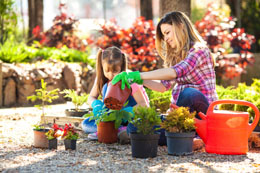While growing plants for the first time, beginners need to know the characteristics of the plant they select and its optimum growing conditions. More gardening knowledge comes with further experience. The following section gives some gardening tips for beginners.

Gardening is a wonderful hobby which also provides some physical activity and exercise in today's stressful life. For the elderly, gardening of any sort is an ideal way to remain active and involved in relaxing activities.
When it comes to gardening, the method is the same for beginners and seasoned gardeners alike. The only things that a novice has to learn is selecting the plant varieties and the garden type (indoor, container, flower, and vegetable gardening), which comes with practice. With time and experimentation, anybody can become an ardent gardener. Given below are some instructions for various types of gardens.
Vegetable Gardening
The steps pertaining to planting a vegetable garden for the first time are:
- First and foremost, select the plantation site, that is, plan the garden layout. Opt for areas that receive ample sunlight--for maintenance of healthy vegetables.
- Prepare the soil in this selected area. Using an appropriate garden tool, loosen the soil and remove the weeds or unwanted grass. Expose the garden soil to sunlight for a few days before planting the vegetable seeds.
- If the planting site is large, you can separate it into garden rows. Leave a small space between two rows to perform gardening activities and to have easy access to the plants.
- Following this, plant the vegetable saplings or sow the seeds, depending on the plant. Vegetables that require least maintenance are tomato, cucumber, spinach, onion, garlic, carrot, squash, beet, and herbs among others.
- Water the planted vegetables whenever the upper soil layer turns dry. Frequent watering is essential in dry climates. Remove any diseased parts of the plant and uproot the weeds.
Flower Gardening
Maintaining a flower garden requires some basic steps, such as selecting varieties specific for the season, soil preparation, and extra care for timely blooming. Instructions for a flower garden are:
- Planning a flower garden layout is a bit tricky, as your overall garden appearance depends on it. You can start by preparing the soil and creating equal-sized rows in sunlit areas. The most crucial part is selecting flower varieties which are perfect for the current season.
- The best way to choose season-appropriate flowers is to get an opinion from your local horticulturist. Apart from the flower size, color, and plant height, make a note of the level of maintenance that each plant requires. As a beginner, preferably start with hardy flower species.
- Decide the plantation area according to the flower color and height. You can also create a border for the flower beds with contrasting colored flowers. Once you are done with the layout plan, proceed with growing the plantlets.
- Practice the regular plant care tips to ensure timely flowering and production of healthy blooms.
Organic Gardening
Generally speaking, there is no difference between a regular garden and an organic garden. The only distinguishing point is using chemical-free soil and organic plant cultivars in the latter type. To be more precise, organic gardening is focused on establishing an environment-friendly garden. Thus, farmyard compost, natural fertilizers, and chemical free pesticides are used in an organic garden.
If you do not have a plot or yard, consider learning 'container gardening'. You will need large pots, a potting mixture, and plantlets or seeds (whichever is applicable). Move or rearrange the potted plants as required. Finally, do not forget to involve kids in gardening activities. This way, they will understand the importance of plants in nature for ecological balance.






 Gardening is a wonderful hobby which also provides some physical activity and exercise in today's stressful life. For the elderly, gardening of any sort is an ideal way to remain active and involved in relaxing activities.
Gardening is a wonderful hobby which also provides some physical activity and exercise in today's stressful life. For the elderly, gardening of any sort is an ideal way to remain active and involved in relaxing activities.